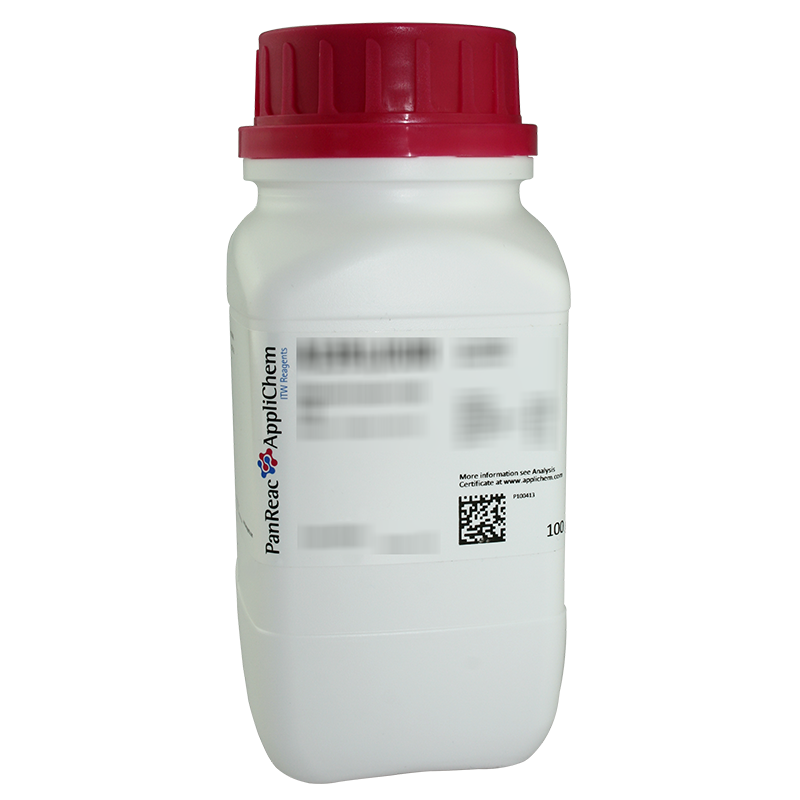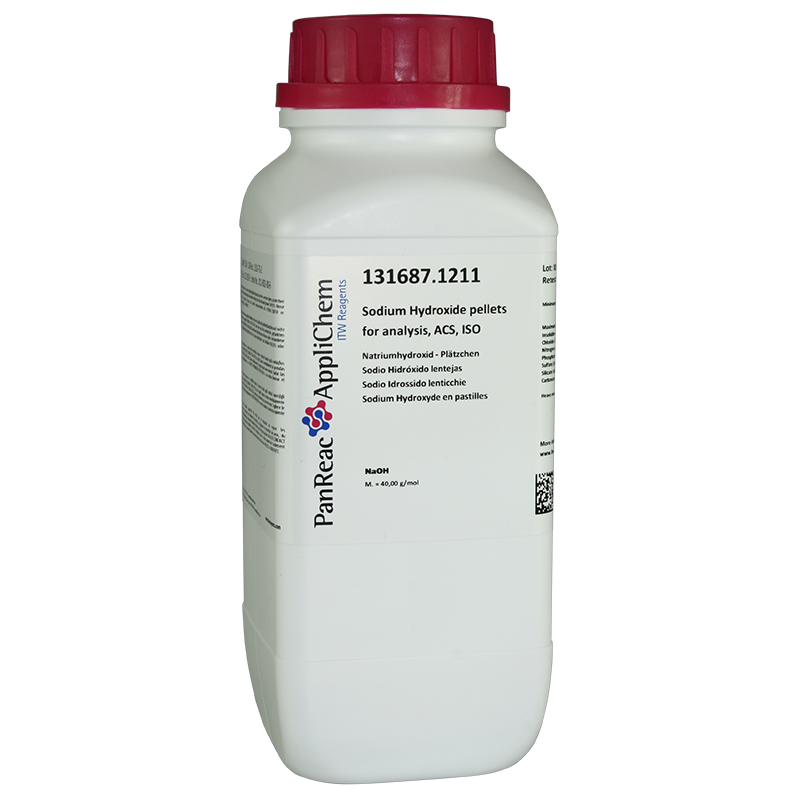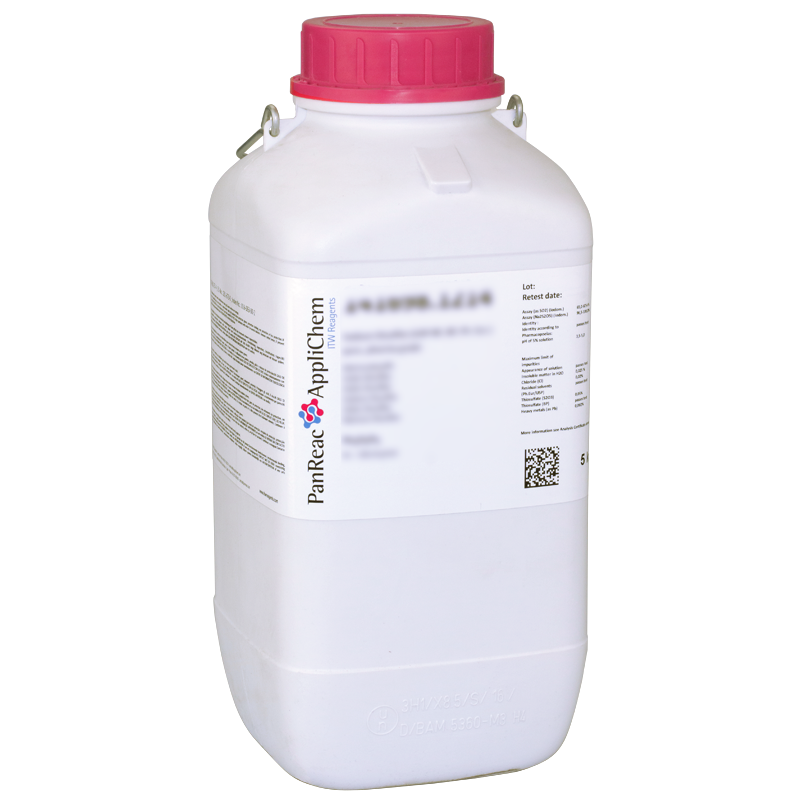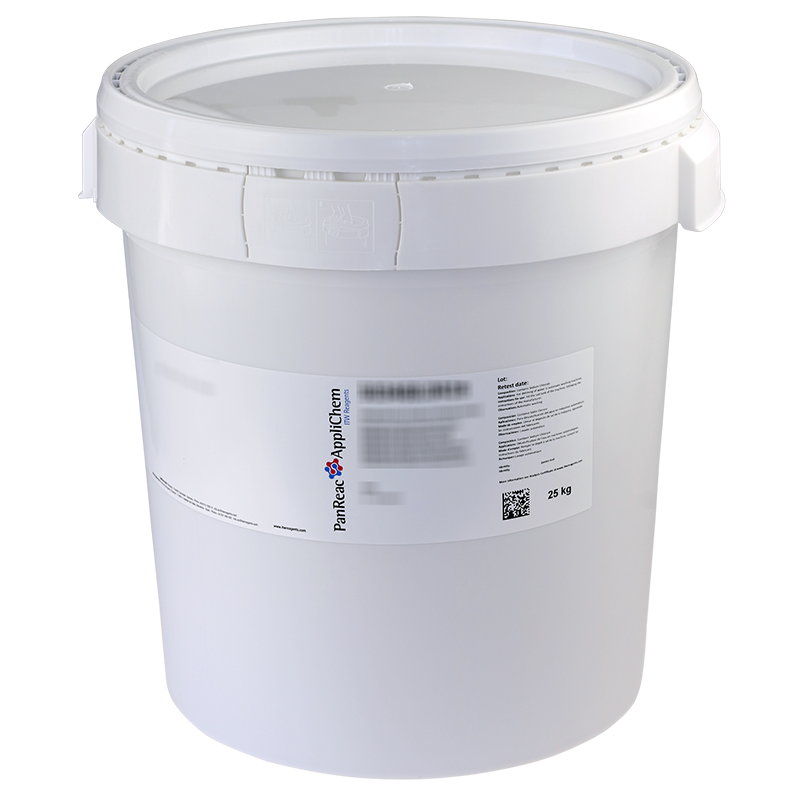Packs sizes (4)
| code | packaging size | price per unit | box price per unit | |
|---|---|---|---|---|
| Code & packaging | Price per piece | |||

|
code
131687.1210
|
packaging size
500 g
|
price per unit
single
$88,80
|
box price per unit
$75,48x 6 units
|

|
code
131687.1211
|
packaging size
1000 g
|
price per unit
single
$105,90
|
box price per unit
$90,02x 6 units
|

|
code
131687.1214
|
packaging size
5 kg
|
price per unit
single
$417,30
|
box price per unit
$354,71x 4 units
|

|
code
131687.0416
|
packaging size
25 kg
|
price per unit
single
$957,90
|
box price per unit
|
Technical data
- Melting Point:
- 318 °C
- Boiling Point:
- 1,390 °C
- Solubility:
- water 1,090 g/l at 20 °C
- Physical Description:
- solid
White solid as lentils or flakes, frosted, caustic deliquescent, absorbing CO2 from the air
- Product Code:
- 131687
- Product Name:
- Sodium Hydroxide pellets (Reag. USP) for analysis, ACS, ISO
- Quality Name:
- for analysis, ACS, ISO
- Specifications:
- Minimum assay (Acidim.): 98.0%
Maximum limit of impurities
Insoluble matter in H2O: 0.005 %
Chloride (Cl): 0.005%
Nitrogen compounds (as N): 0.0005%
Phosphate (PO4): 0.0005 %
Sulfate (SO4): 0.003%
Silicate SiO2: 0.001%
Carbonate (as Na2CO3): 1.0%
Heavy metals (as Pb): 0.0005%
Al: 0.0005 %
As: 0.00004 %
Ca: 0.0005 %
Cd: 0.0005 %
Co: 0.0005 %
Cu: 0.0005 %
Fe: 0.0005 %
Hg: 0.00001 %
K: 0.02 %
Mg: 0.0005 %
Mn: 0.0005 %
Ni: 0.0005 %
Pb: 0.0005 %
Zn: 0.001 %
- Hazard pictograms
-
- UN:
- 1823
- Class/PG:
- 8/II
- ADR:
- 8/II
- IMDG:
- 8/II
- IATA:
- 8/II
- WGK:
- 1
- Storage:
- Room Temperature.
- Signal Word:
- Danger
- GHS Symbols:
- GHS05
- H Phrases:
- H314
H290
- P Phrases:
- P260
P280
P303+P361+P353
P501
P305+P351+P338
P310
- Master Name:
- Sodium Hydroxide pellets
- Synonyms Long Text:
- Caustic Soda
- EINECS:
- 215-185-5
- CS:
- 28151100
- Index Nr.:
- 011-002-00-6
Documents
Inquiry
Comments
Sodium Hydroxide / Caustic sodaAbout Sodium hydroxide
Sodium hydroxide (also caustic soda), chemical formula NaOH, is a white hygroscopic solid. With a world production of 60 million tons in 2010, the compound is one of the most important basic chemical materials and is mainly traded in the form of caustic soda.
Production
In the laboratory, sodium hydroxide can be prepared by reacting sodium carbonate with calcium hydroxide to give sodium hydroxide and calcium carbonate:
Na2CO3 + Ca(OH)2 → 2 NaOH + CaCO3.
The calcium carbonate, which is not very soluble, is filtered off. The highly soluble sodium hydroxide remains in the filtrate. This process of causticization used to be carried out on a large scale and is again of interest today. Another method is the strongly exothermic reaction of elemental sodium with water to form sodium hydroxide and hydrogen:
2 Na + 2 H2O → 2 NaOH + H2
At school, this experiment is often shown to demonstrate the reactivity of alkali metals with water. After evaporation of the water, solid sodium hydroxide remains:
NaOH (aq) → NaOH (s).
The Acker process for the preparation of sodium hydroxide by fused-salt electrolysis of sodium chloride was developed by Charles Ernest Acker (1868-1920) in the United States of America.
Electrolysis
Industrially, sodium hydroxide is produced by electrolysis of sodium chloride to caustic soda, hydrogen and chlorine gas:
2 NaCl +2 H2O → Cl2 + H2 + 2 NaOH.
There are three different process technologies for this:
1. amalgam process
2. diaphragm process,
3. membrane process
Common to all processes are additional purification and concentration stages to obtain anhydrous sodium hydroxide. Since the demand for chlorine has stagnated since the 1980s, the caustic soda produced as a by-product of chlor-alkali electrolysis no longer fully covers world demand, making recausticizing interesting again.
Properties
Physico-chemical properties
Sodium hydroxide is a white hygroscopic solid and is one of the strongest bases. In water it dissolves very well under great heat generation due to the negative enthalpy of solution of -44.4 kJ/mol to the strongly alkaline reacting sodium hydroxide solution (pH 14 at c = 1 mol/L). It is always completely dissociated in aqueous solution. However, at higher concentrations, the interionic forces between the sodium and the hydroxide ions make themselves felt on the free mobility of the ions, so that a normal solution (40 g sodium hydroxide in a liter) appears to be about 78% dissociated, a 0.1-n solution about 90%. It reacts with carbon dioxide in the air to form sodium hydrogen carbonate and is therefore stored in airtight containers. To prevent the sodium hydroxide from binding water from the air, it can be stored together with a desiccant. As a strong base, the hydroxide ion displaces weaker and volatile bases from their salts.
Crystal structure
Between room temperature and melting point, 318.4 °C, anhydrous sodium hydroxide occurs in two modifications. Below 299.6 °C (α-modification), sodium hydroxide crystallizes with an orthorhombic crystal structure with the space group Cmcm (space group no. 63), above this (β-modification) lower symmetrically with a monoclinic crystal structure with the space group P21/m (space group no. 11). The sodium hydroxide molecule is linear and in this order parallel to the c-axis. Sodium and oxygen form extended bilayers similar to the sodium chloride structure in x,y, with sodium and oxygen alternating in the directions (x-y). The layer thickness is slightly greater than the sodium-oxygen distance in the molecule. Longitudinally c consecutive layers are shifted by 1/2 a. The lattice constants at 24 °C are a = b = 3.3994 ± 0.001 Å, c = 11.377 ± 0.005 Å, α = β = γ = 90°. The molecule is angled in the [010] plane. The angle β depends on the temperature. As the temperature increases, so does the approximation to the type of sodium chloride structure present in sodium fluoride. α-Sodium hydroxide is often twinned according to [110]. The β-modification is always twinned to approximately equal volume fractions according to [001]. It emerges from the α-form by shifting the layers longitudinally [100]. The structure of the bilayers is preserved.[12] In addition, the compound occurs in several hydrate forms. Thus, the mono-, di-, 3,5-, tetra-, penta-, and heptahydrate are known. The metastable form of the tetrahydrate β-NaOH-4 H2O has an orthorhombic crystal structure with space group P212121 (space group no. 19) with four formula units per unit cell and lattice constants a = 6.237, b = 6.288, c = 13.121 Å at -155 °C. The hydrates NaOH-3.5H2O and NaOH-7H2O each have a crystal structure with space group P21/c (space group no. 14) with eight formula units per unit cell (lattice constants a = 6.481, b = 12.460, c = 11.681 Å, β = 104.12° at -100 °C) and four formula units per unit cell (a = 7.344, b = 16.356, c = 6.897 Å, β = 92.91° at -150 °C), respectively. The monohydrate melts at 64.3 °C, the 3,5-hydrate at 15.6 °C.
Reactions
If sodium hydroxide is stored unsealed in air, it reacts with carbon dioxide to form sodium hydrogen carbonate or sodium carbonate, so it is stored in airtight containers.
NaOH + CO2 = NaHCO3
2 NaOH + CO2 = Na2CO3 + H2O
In the laboratory, ammonia is easily produced by the acid-base reaction of sodium hydroxide and ammonium chloride.
NaOH + NH4Cl = NH3 + NaCl + H2O
As a solution, it reacts with aluminum (to form aluminum sodium dioxide) and many other metals, such as iron, copper, cadmium, cobalt, and titanium.
2 Al + 2 NaOH + 2 H2O = 2 NaAlO2 + 3 H2
Sodium hydroxide reacts with acids to form salts, and the heat generated is so considerable that an explosion occurs with strong acids, for example, when concentrated sulfuric acid is dropped onto powdered sodium hydroxide.
Commercial form
Sodium hydroxide is commercially available in plastic containers in an airtight package in the form of small beads or as pellets.
Use
Sodium hydroxide is mainly used in the form of caustic soda and is one of the most important chemicals in industry. Solid sodium hydroxide, along with aluminum chips, is an essential ingredient in drain cleaners. When dissolved in water, the strong base oxidizes aluminum under heat and hydrogen evolution and then dissolves fats and proteins in the deposits by saponification. Hot solution is used to dissolve fire deposits in cooking pots. Sodium hydroxide is not suitable for aluminum pots.
Caustic Soda
Caustic soda is the name for alkaline solutions of sodium hydroxide (NaOH) in water.
Properties
Sodium hydroxide dissolves very well in water under strong heat. A saturated aqueous solution at room temperature contains 1260 g of sodium hydroxide to one liter of water. Caustic soda is one of the most commonly used laboratory and industrial chemicals. Concentrated caustic soda is highly corrosive to the skin, and even very dilute caustic soda can damage the cornea of the eyes to the point of causing blindness. One-molar sodium hydroxide solution (a solution containing one mole of NaOH (40 g) in one liter; equivalent to about 3.9 wt%) has a pH of 14.
Extraction – Caustic soda is usually obtained by electrolysis from an aqueous solution of sodium chloride. This method is called chlor-alkali electrolysis. Various technical processes can be used. The reaction equation for the overall reaction is:
2 NaCl + 2 H2O = 2 NaOH + Cl2 + H2
Chlorine is also produced in the process. The chemical industry's great need for caustic soda has contributed significantly to the development of chlorine chemistry. Electrolysis can also be used to convert other metal salts to their hydroxides. For example, if potassium chloride is used instead of sodium chloride, potassium hydroxide solution is obtained. Chlor-alkali electrolysis is an endothermic reaction. The required energy is supplied in the form of electric current. Caustic soda can also be washed from red mud.
Use
- Synthesis of various chemicals, for example formic acid, sodium hypochlorite, sodium phosphate, sodium sulfide.
- Production of various sodium soaps.
- In the chemical industry for neutralization of acids in a variety of chemical processes.
- Digestion of bauxite and other ores (Bayer process for the production of aluminum).
- Processing: removal of old paint (paint stripper), regeneration of rubber and ion exchangers, finishing of cotton (mercerization), pulp extraction (cellulose).
- In the food industry: rinsing of bottles in beverage bottling plants, removal of greasy and oily impurities, cleaning of stainless steel tanks, removal of peels from fruit as well as vegetables, in the production of lye pastries as food additive E 524 for the brown coloring and the "soapy" taste, for pickling olives.
- In agriculture and cheese dairies for cleaning milking machines, hoses, pipes and milk cooling tanks.
- In beekeeping: for cleaning bee hives and frames.
- In the pharmaceutical industry, acidic poorly soluble drugs, for example hexobarbital, isotretinoin, ketorolac, are often converted into sodium salts with caustic soda, which are then more water-soluble or have other galenic advantages.
- In household use as a drain cleaner.
- In printed circuit board manufacturing to develop the layout previously transferred to the photo-coated board with ultraviolet radiation.
Storage
Caustic soda should never be stored in vessels with ground glass stoppers. Sodium bicarbonate forms on the ground joint with the carbon dioxide from the air: This salt crust sticks the ground joint to the sleeve. In addition, sodium hydroxide attacks most glassware, which is why it is generally recommended above a concentration of 0.1 mol/L to use an alkali-inert container, e.g. made of polyethylene, with a screw cap or, if necessary, rubber stoppers for a short time. For volumetric NaOH solutions, glass vessels are completely prohibited.
Disposal
Caustic soda, like all alkalis, must be neutralized with suitable acids before being introduced into the sewage system. If necessary, the concentration of the resulting salts must then be reduced by dilution. Small quantities, such as also occur when using certain cleaning agents, must only be sufficiently diluted.





